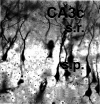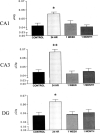Is neuronal death required for seizure-induced epileptogenesis in the immature brain?
- PMID: 12143355
- PMCID: PMC3084550
- DOI: 10.1016/S0079-6123(02)35033-7
Is neuronal death required for seizure-induced epileptogenesis in the immature brain?
Abstract
Do seizures cause neuronal death? At least in the immature hippocampus, this may not be the critical question for determining the mechanisms of epileptogenesis. Neuronal injury and death have clearly been shown to occur in most epilepsy models in the mature brain, and are widely considered a prerequisite to seizure-induced epilepsy. In contrast, little neuronal death occurs after even a severe and prolonged seizure prior to the third postnatal week. However, seizures early in life, for example prolonged experimental febrile seizures, can profoundly and permanently change the hippocampal circuit in a pro-epileptogenic direction. These seizure-induced alterations of limbic excitability may require transient structural injury, but are mainly due to functional changes in expression of gene coding for specific receptors and channels, leading to altered functional properties of hippocampal neurons. Thus, in some pro-epileptogenic models in the developing brain, neither the death of neurons nor death-induced abnormalities of surviving neurons may underlie the formation of an epileptic circuit. Rather, findings in the experimental prolonged febrile seizure model suggest that persistent functional alterations of gene expression ('neuroplasticity') in diverse hippocampal neuronal populations may promote pro-epileptogenic processes induced by these seizures. These findings also suggest that during development, relatively short, intense bursts of neuronal activity may disrupt 'normal' programmed maturational processes to result in permanent, selective alterations of gene expression, with profound functional consequences. Therefore, determining the cascade of changes in the programmed expression of pertinent genes, including their temporal and cell-specific spatial profiles, may provide important information for understanding the process of transformation of an evolving, maturing hippocampal network into one which is hyperexcitable.
Figures


References
-
- Albala BJ, Moshe SL, Okada R. Kainic-acid-induced seizures: a developmental study. Brain Res. 1984;315:139–148. - PubMed
-
- Armstrong DD. The neuropathology of temporal lobe epilepsy. J. Neuropathal. Exp. Neural. 1993;52:433–443. - PubMed
-
- Babb TL, Brown BJ. Pathological findings in epilepsy. In: Engel J, editor. Surgical Treatment of the Epilepsies. Raven; New York, NY: 1987. pp. 511–552.

